Get Into Your Sanctuary Workshop for youth
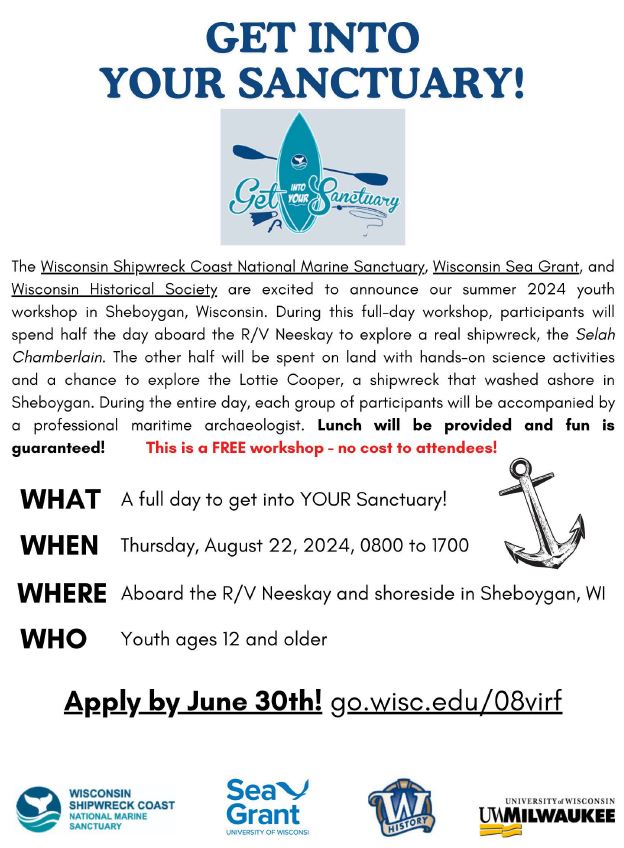
Blog | Wisconsin Sea Grant
https://www.seagrant.wisc.edu/blog/get-into-your-sanctuary-workshop-for-youth/

Blog | Wisconsin Sea Grant
https://www.seagrant.wisc.edu/blog/get-into-your-sanctuary-workshop-for-youth/
As a diver, Tamara Thomsen can see not only down through the waves but also into the past. As it turns out, following a recreational frolic last summer using a type of underwater scooter, she can see quite far into the past.
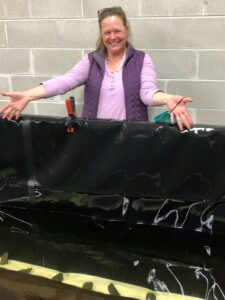
Tamara Thomsen beams while standing over a water-filled crib that holds the 1,200-year-old dugout canoe she discovered. The canoe is undergoing a preservation process in the water that will ready it for eventual public display. Photo: Moira Harrington
That day in June 2021 Thomsen, a maritime archeologist with the Wisconsin Historical Society (WHS) and longtime Wisconsin Sea Grant collaborator, discovered a 1,200-year-old dugout canoe, the oldest intact shipwreck found in Wisconsin. It also had artifacts with it.
Thomsen knows shipwrecks. She has prepped dozens of nominations for lakes Michigan and Superior shipwrecks for listing on the National Register of Historic Places. She is the driving force behind the popular WHS/Sea Grant joint website wisconsinshipwrecks.org. She has been inducted into the Women Divers Hall of Fame. Along with fellow marine archeologist Caitlin Zant, she recently worked with educators to create six distinct maritime educational activities based on data from previous Sea Grant projects on Wisconsin maritime archaeology. With Sea Grant project support, in 2021 Zant and Thomsen delivered 11 maritime historic preservation presentations that reached nearly 530 people.
Floating onto this already impressive scene is the dugout canoe. The tale of its first sighting is a lesson in serendipity and the value of strong-arming a colleague to double-check on a chance encounter that Thomsen describes with a chuckle as, “Swimming around under the water, I don’t see logs, I see dugout canoes.”
That discovery day, after she spotted what she thought was a partially submerged-in-sediment canoe in 26 feet of water, Thomsen needed to return to land because her underwater scooter partner at the time had reached the designated turn-around point for the air volume in her tank. Thomsen, however, was itching to go back and pursue her hunch that this was more than any old chunk of wood. On that same Saturday, Thomsen convinced a colleague, Amy Rosebrough, to accompany her in a boat back to the site following the coordinates she had noted on the first go-round.
Rosebrough is not a diver. She is a WHS terrestrial archeologist, but Thomsen knew she would make a good sounding board for assessing the site. At the marked location, Thomsen descended in her diving gear once more, gently shifting sediment to get a better look at the sunken craft. She also resurfaced with seven flat stones, some notched, which had been resting in the canoe. After Rosebrough’s examination, Thomsen replaced the stones in the canoe, and replaced sediment around the canoe to offer it protection.
The pair returned to shore and Rosebrough spent the evening pondering the assortment of rocks, which she then deduced were sinker weights for a fishing net, a net long since lost in the waters of Lake Mendota, one of Madison, Wisconsin’s, four lakes.
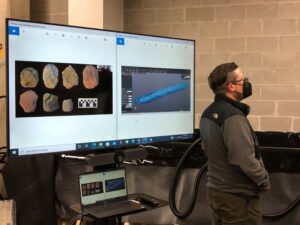
The seven rocks recovered with the canoe are pictured to the left on a large electronic display in the room where the canoe is being preserved. On the right side of the screen is a 3-D image of the canoe. Photo: Moira Harrington
The canoe’s discovery fell at a time of transition for the WHS. James Skibo, the state archeologist, had just come onboard. While giving him a few weeks to settle into his new role, Thomsen and Zant also kept reminding him about the canoe, soon fully enlisting his help in further investigation. Skibo and Thomsen went back to the lake and retrieved what Skibo termed a piece of wood “about the size of a piece of hair” for radiocarbon dating.
The check was necessary, he said, “Because we didn’t want to be fooled. The canoe could have been a Boy Scout project from the 1950s.”
The results showed not a replica built by pre-teen boys but the real deal, a canoe from AD 800. From that point on, Skibo said, WHS Director Christian Overland was all-in with support for recovering, preserving and sharing this amazing object. That is also certainly in keeping with Skibo’s own ethic, as he explained, in his role serving as the people’s archeologist.
On Nov. 2, 2021, after weeks of planning, preparation and involvement by WHS staff and the Dane County Sheriff’s Office Dive Team, the canoe was recovered from the lake. A WHS video details the process. Recovery was deemed necessary because as sediment had shifted and the canoe was partially uncovered, disintegration would quickly follow.
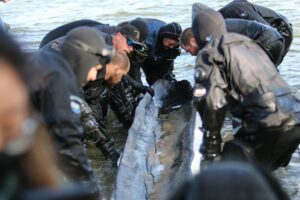
Bringing the canoe into shore from Lake Mendota in Madison, Wisconsin, represented the culmination of weeks of planning and team contributions. Photo: Wisconsin Historical Society
Skibo said at every step of the process since discovery, Wisconsin’s Indigenous leaders have been consulted, and they also supported the removal, and now, preservation work. Further, Skibo said, repatriating human remains and sacred objects is a well-established practice of the WHS. In this instance, the canoe was in the public domain, is state property and had neither human remains nor sacred objects as part of the site.
On a recent visit to a WHS preservation facility, this writer was fortunate to see the canoe. The old adage, “if this object could talk, what would it say,” came to mind. It was a powerful moment to reflect that it had been more than a millennium since people had used this vessel, which resembles a slightly charred version of a modern-day paddleboard, but one with narrow and shallow sides. It is 15 feet long, weighs 280 pounds and has a gaping and practically symmetrical hole in the base of one end, likely the damage that sealed its sinking fate. At the other end of the canoe, the one that had been exposed from the lakebed and originally caught Thomsen’s eye, it is slightly split.
Its beginnings? It was hewn from a felled white oak tree. Fire was perhaps used to assist in hollowing it out. It probably sank near to where it was made, offshore from a small seasonal village of a woodland people who hunted, fished and tended gardens of corn, sunflowers and squash. These people were also mound builders.
Its future? The canoe is now resting in a wood-framed crib-like structure layered with three pond liners and filled with 15 inches of purified water as part of a nearly three-year-long preservation process that includes replacing the water that is essentially the only thing maintaining the canoe’s structure via osmosis with polyethylene glycol, which will coat and strengthen the canoe’s interior cells. At the end of the process, the canoe will be freeze-dried at minus 22 degrees Celsius to remove any remaining water.
It is expected that this ancient shipwreck will be given a place of pride in a new WHS museum anticipated to open in 2026 in Madison. Upon display, this writer looks forward to experiencing the powerful feelings the canoe first elicited. It is also a celebration of the ingenuity and dedication of WHS staff who have done and will continue to tell the story of this canoe and the people who created it.
The post A visit to Wisconsin’s oldest intact shipwreck first appeared on Wisconsin Sea Grant.News Releases | Wisconsin Sea Grant
News Releases | Wisconsin Sea Grant
https://www.seagrant.wisc.edu/news/a-visit-to-wisconsins-oldest-intact-shipwreck/?utm_source=rss&utm_medium=rss&utm_campaign=a-visit-to-wisconsins-oldest-intact-shipwreck

A free online video game for children about a Great Lakes shipwreck is now available. “The Legend of the Lost Emerald,” is a point-and-click adventure game designed for players grades 4-6. It was developed by the University of Wisconsin-Madison’s Field Day Lab in partnership with Wisconsin Sea Grant, PBS Wisconsin Education and the Wisconsin Historical Society. Teacher fellows offered insights at every step of the game’s development. Funding was provided by PBS Wisconsin Education with additional help from the Wisconsin Coastal Management Program and Sea Grant.
Players must use critical thinking and historical inquiry skills to find the wreck as they step into the shoes of Jules, a maritime archaeologist, with help from a cast of diverse family members. Players dive underwater to gather clues, build evidence and uncover the real treasure – stories of shipwrecks inspired by Great Lakes history. It takes two classroom sessions to complete (about 2 hours).
“The goal of the game is to connect students with the maritime history in their own state – to go beyond the story of the Titanic,” said Anne Moser, senior special librarian and education coordinator for Wisconsin Sea Grant. “It includes topics like lake ecology, maritime archaeology, trade and commerce.”
The post Online shipwreck game educates players first appeared on Wisconsin Sea Grant.News Releases | Wisconsin Sea Grant
News Releases | Wisconsin Sea Grant
https://www.seagrant.wisc.edu/news/online-shipwreck-game-educates-players/?utm_source=rss&utm_medium=rss&utm_campaign=online-shipwreck-game-educates-players
By Eva Ryan, University of Wisconsin-Madison
To further celebrate the Wisconsin Sea Grant 50th anniversary, I had the opportunity to interview Ginny Carlton, education outreach specialist. Ginny gave me insights into the changes in her field from the past 50 years and hopeful changes for the next 50.
Carlton provides learning opportunities to an array of different people including K-12 students and teachers, as well as catering to other audiences through programs like Grandparent’s University. The education branch also hosts webinars that are open to the public. Some of these webinars have recently been associated with the Center for Great Lakes Literacy (CGLL). The CGLL allows Sea Grant education specialists from across the Great Lakes basin to collaborate and produce educational products and programs. For example, the Trash Trunk is an educational kit that explores what marine debris is, its impacts and what can be done about it.
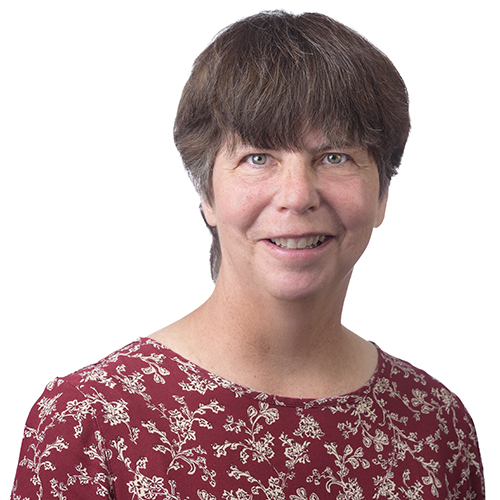
Ginny Carlton. Image credit: Wisconsin Sea Grant
“I think that’s one of the really wonderful things about Sea Grant; the education isn’t just left to me,” Carlton said. “As the education outreach specialist, I have the opportunity to work with a lot of our other colleagues at Sea Grant.” For example, Anne Moser, Adam Bechle and Carlton are collaborating on a NOAA-funded grant project that provides seventh grade students in the Racine Unified School District with educational opportunities related to coastal engineering concepts.
Though Carlton started her position at Sea Grant in 2019, she has observed several changes within the education field from the past 50 years. One of the details she listed was research into neural science, specifically the way people process and retain information.
Another change in the education field is a greater focus on place-based education. While early educational movements, such as nature study and conservation education, acknowledged ecological differences between one location and another, place-based education expands the concept of place beyond just geography. Place-based education uses aspects of the students’ environment like culture, ecology and economy to make connections between their education and local community.
Though the education field has made strides in becoming more inclusive and optimal for student learning, there are always improvements to be made. “I hope we find ways to more fully open learning opportunities to everybody,” Carlton said. She noted that the COVID-19 pandemic has highlighted the fact that not everyone has the same opportunities as others all of the time.
“At Sea Grant, we’re very fortunate because we have wonderful partners who can, and do, help with the work,” Carlton said. Sea Grant works with a variety of partners to design, promote, deliver and evaluate diverse educational offerings and products, which in turn helps all of us to reach a larger audience with important educational messages about the Great Lakes and people’s relationships to them. For example, a recent project, ROVe the Great Lakes, created in partnership with the Wisconsin Historical Society, features the work of maritime archaeologists who use remotely operated vehicles in their work.
Despite this impressive feat, Carlton has her sights set on further improving her field. “We have to work collaboratively to meet the needs of as many people as we possibly can,” said Carlton, “In this way, we advance our mission to promote the sustainable use of Great Lakes resources and reach our vision of thriving coastal ecosystems and communities.”
The post How far education has come and where we hope it’s going first appeared on Wisconsin Sea Grant.
Blog | Wisconsin Sea Grant
https://www.seagrant.wisc.edu/blog/how-far-education-has-come-and-where-we-hope-its-going/?utm_source=rss&utm_medium=rss&utm_campaign=how-far-education-has-come-and-where-we-hope-its-going
The fall season of Wisconsin’s Sea Grant’s “Lake Talks” continues on Thursday, Oct. 14, from 7-8 p.m. Speaker Caitlin Zant, a maritime archaeologist with the Wisconsin Historical Society, will focus on “Shipwrecks of Wisconsin.”
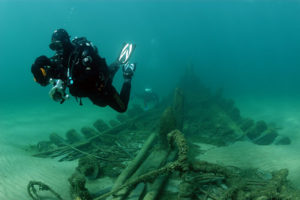
A diver examines the wreck of the Australasia, which sank in Lake Michigan in 1896 following a fire on board. Fortunately, no lives were lost. (Photo: Wisconsin Historical Society)
The virtual event, held on Zoom, is open to everyone, though registration is required. (Register for this event now.) The hour includes time for audience questions.
Attendees will discover hidden history beneath our waters and explore some of Wisconsin’s 750 Great Lakes shipwrecks. Learn how maritime archaeologists document these time capsules and help preserve and protect Wisconsin’s rich maritime past. Of any state, Wisconsin has the most individually listed shipwrecks on the National Register of Historic Places.
Zant has been a maritime archaeologist at the Historical Society since 2014. She holds a master’s degree in maritime studies and underwater archaeology from East Carolina University in Greenville, North Carolina. Prior to that, she earned a bachelor’s degree in history, geography and earth sciences at Carthage College in Kenosha, Wisconsin. She holds the RPA credential from the Register of Professional Archaeologists.
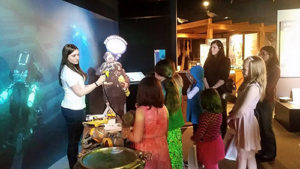
Caitlin Zant talks to Girl Scouts at the Wisconsin Maritime Museum about shipwrecks and the aquatic sciences. (Photo: Wendy Lutzke)
She is also a Wisconsin Sea Grant-funded investigator currently working on a project called “Boatloads of Lumber,” which includes both the development of educational materials for kids of all ages and a field school to train recreational divers and archaeology enthusiasts in proper techniques for surveying and documenting shipwrecks.
Remaining Lake Talks in the fall season will focus on Great Lakes children’s literature by Native American authors (November) and a conversation with Minnesota-based poet Moheb Soliman, who draws upon his Great Lakes travels in his work, including his most recent poetry collection, HOMES (December). Those talks will also be delivered via Zoom.
For Lake Talks event and registration information, visit the Sea Grant website, or follow Wisconsin Sea Grant on Facebook or Twitter. You can register for Caitlin Zant’s shipwreck presentation now.
For questions about this series, contact Wisconsin Sea Grant science communicator Jennifer Smith.
The post Lake Talks series to explore Wisconsin shipwrecks with maritime archaeologist first appeared on Wisconsin Sea Grant.News Releases | Wisconsin Sea Grant
News Releases | Wisconsin Sea Grant
https://www.seagrant.wisc.edu/news/lake-talks-series-to-explore-wisconsin-shipwrecks-with-maritime-archaeologist/?utm_source=rss&utm_medium=rss&utm_campaign=lake-talks-series-to-explore-wisconsin-shipwrecks-with-maritime-archaeologist
A century ago, Lake Michigan was a busy water highway for the lumber trade, connecting merchants in northern Wisconsin and Michigan with customers in bustling cities like Milwaukee and Chicago. While this Great Lakes lumber trade persisted into the 1920s and ‘30s, it peaked in the late 1800s. At one time, about 500 vessels traversed Lake Michigan as part of this trade, before rail and eventually trucking took over.
Shipwrecks help tell the story of the Great Lakes lumber trade. The Wisconsin Historical Society’s (WHS) highly active program in maritime archaeology documents these and other wrecks and shares its findings through a variety of educational efforts.
Now, through funding from Wisconsin Sea Grant, WHS is embarking on a new, two-year project called “Boatloads of Lumber.” One key outcome will be online learning resources tailored to a range of ages. WHS Maritime Archaeologists Caitlin Zant and Tamara Thomsen will lead the project, which also involves Wisconsin Sea Grant’s Anne Moser, who oversees the Wisconsin Water Library and education activities.
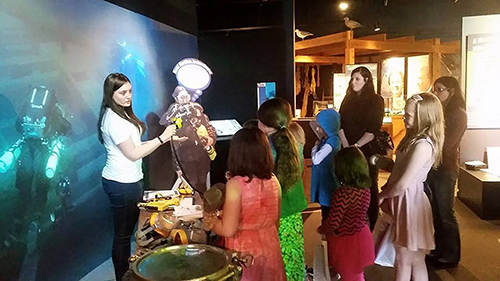
Caitlin Zant talks to Girl Scouts at the Wisconsin Maritime Museum about shipwrecks and the aquatic sciences. (Photo: Wendy Lutzke)
Said Zant, “Our program [at the Historical Society] does a lot of outreach and education, but a lot of it is focused on public presentations to a broad audience, and not really working as closely as we might with museum educators to create programming and activities for kids of all ages.”
Zant said requests have been increasing to speak to groups like 4-H, Boy Scouts and Girl Scouts.
Although this project, a part of Sea Grant’s 2020-22 funding cycle, has been in the planning stages for quite some time, the current COVID-19 pandemic and rapid shift to online instruction has made it even more relevant.
Said Zant, “Especially with recent events, everyone’s clamoring for this kind of content that anyone can teach to kids, to keep education going no matter what the age or no matter what the circumstances.”
The online resources will be developed in concert with museum educators, including those at museums devoted to maritime history. Collaborators include the Wisconsin Maritime Museum in Manitowoc, the Port Exploreum in Port Washington and the Door County Maritime Museum’s locations in Sturgeon Bay and Gills Rock.
By end of year one, Zant said that museum educators will have tested draft versions of the new resources. Feedback from the educators will help the team refine the tools, and final versions will be ready by the end of year two.
Sea Grant’s Moser will help ensure that the tools convey a cohesive message in terms of Great Lakes literacy. Shipwrecks can be a way for learners of all ages to connect with other issues affecting the Great Lakes, from aquatic invasive species and water quality to currents and sand movement.
A second key aspect of the “Boatloads of Lumber” project is a field school to help recreational divers and archaeology enthusiasts learn techniques to properly survey and document wrecks they may find.
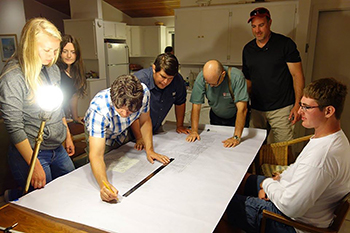
After a day of diving and collecting data, students in the 2015 field school work on the site plan of the shipwreck Grape Shot. (Photo: Tamara Thomsen, Wisconsin Historical Society)
As Zant noted, her office at WHS does not go out in search of shipwrecks, generally speaking. However, they do get valuable tips from members of the public when shifting sands and varying water levels uncover parts of a wreck. With training, history buffs and divers can learn more about maritime archaeology skills like how to draw underwater.
WHS first tried a field school approach in 2015, working with the Wisconsin Underwater Archaeology Association on a wreck in Door County. It was a great success.
For the current grant project, the focus will be on the Sidney O. Neff, a wooden vessel built in 1890 by a Manitowoc company. It sank in 1939 with no loss of life. Now it lies, heavily covered by invasive quagga mussels, in about 12 feet of water near the Marinette lighthouse.
Said Zant, “The Sidney O. Neff is well suited for learning because it is in a relatively protected area” with fairly shallow water. “Over the course of the project, students can come up out of the water and ask questions. We try to make [the field school] as safe an environment as possible. Sometimes people are working underwater for the first time.”
The Minnesota-based Great Lakes Shipwreck Preservation Society has been a key partner in these field schools and will also participate in the Sidney O. Neff project.
Thanks to the diligence of Wisconsin’s maritime archaeologists, Wisconsin has the most individually listed shipwrecks on the National Register of Historic Places. (Shipwrecks, like buildings, may also be listed in groups as “districts.”)
The field of maritime archaeology excites Zant because it weaves together so many individual strands, from diving to archival research to public outreach and education. And getting shipwrecks in Wisconsin waters onto the National Register helps preserve and tell a larger story about their importance and history.
Said Zant, “Our state has been really active in using the National Register criteria… as a way to be able record these shipwrecks and then understand their historical significance not only to Wisconsin, but also to the country as a whole. They have this whole backstory that connects Wisconsin to the East Coast, and that connects the East Coast all the way out to the frontier, and it really tells this story on a more national level.”
News Releases – Wisconsin Sea Grant
News Releases – Wisconsin Sea Grant
https://www.seagrant.wisc.edu/news/maritime-archaeology-initiative-will-bring-wisconsins-historic-lumber-trade-alive-for-learners-of-all-ages/